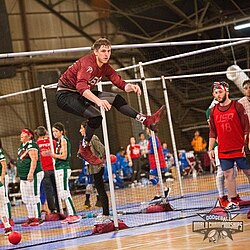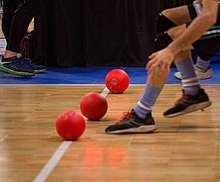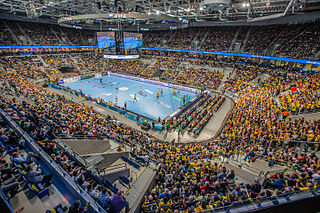
Handball is a team sport in which two teams of seven players each pass a ball using their hands with the aim of throwing it into the goal of the opposing team. A standard match consists of two periods of 30 minutes, and the team that scores more goals wins.

Volleyball is a team sport in which two teams of six players are separated by a net. Each team tries to score points by grounding a ball on the other team's court under organized rules. It has been a part of the official program of the Summer Olympic Games since Tokyo 1964. Beach volleyball was introduced to the programme at the Atlanta 1996 Summer Olympics. The adapted version of volleyball at the Summer Paralympic Games is sitting volleyball.

Squash, sometimes called squash rackets, is a racket-and-ball sport played by two (singles) or four players (doubles) in a four-walled court with a small, hollow, rubber ball. The players alternate in striking the ball with their rackets onto the playable surfaces of the four walls of the court. The objective of the game is to hit the ball in such a way that the opponent is not able to play a valid return. There are about 20 million people who play squash regularly world-wide in over 185 countries. The governing body of squash, the World Squash Federation (WSF), is recognized by the International Olympic Committee (IOC), and the sport is included in the Olympic Games, after a number of applications. Squash has been added for the 2028 Summer Olympics in Los Angeles. The Professional Squash Association (PSA) organizes the pro tour.
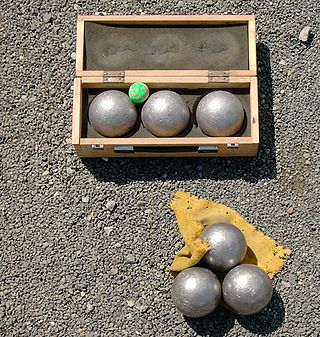
Boules, or jeu de boules, is a collective name for a wide range of games similar to bowls and bocce in which the objective is to throw or roll heavy balls as closely as possible to a small target ball, called the jack. 'Boules' itself is a French loanword that usually refers to the game especially played in France.

Softball is a sport similar to baseball, and it is played with a larger ball on a smaller field and with only underhand pitches permitted. Softball is played competitively at club levels, the college level, and the professional level. The game was first created in 1887 in Chicago by George Hancock.
Guts or disc guts is a disc game inspired by dodgeball, involving teams throwing a flying disc at members of the opposing team.

Throughout the history of baseball, the rules have frequently changed as the game continues to evolve. A few common rules most professional leagues have in common is that four balls is a base on balls, three strikes is a strikeout, and three outs end a half-inning.
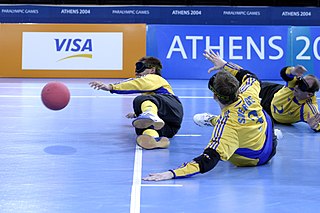
Goalball is a team sport designed specifically for athletes with a vision impairment. Participants compete in teams of three, and try to throw a ball that has bells embedded inside of it into the opponents' goal. The ball is thrown by hand and never kicked. Using ear-hand coordination, originating as a rehabilitation exercise, the sport has no able-bodied equivalent. Able-bodied athletes are also blindfolded when playing this sport.
Extreme Dodgeball is an American game show based on the game of dodgeball that aired between 2004 and 2005 on the Game Show Network. The series ran for three seasons, each of which featured six to eight teams of five to seven players. The first series followed gimmick teams, such as sumo wrestlers and jockeys, which changed over time into the third series with franchise-like teams representing cities. All three series are presented by Bil Dwyer and Zach Selwyn.

Super Dodge Ball is a dodgeball-based sports game produced by Technos Japan Corp. originally released as an arcade game in 1987. In Japan, it was the second game starring Technos Japan's video game character Kunio-kun, following Nekketsu Kōha Kunio-kun, although the connection between the two games was removed in the western release. Various home versions and sequels of the game have been released for various platforms.
Hoover ball is a medicine ball game invented by President Herbert Hoover's personal physician, Medal of Honor recipient Joel T. Boone, to help keep then-President Hoover fit. The Hoover Presidential Library Association and the city of West Branch, Iowa co-host a national championship each year.

Fistball is a sport of European origin, primarily played in the German-speaking nations of Austria, Germany and Switzerland, as well as in Brazil. The objective of the game is similar to volleyball, in that teams try to hit a ball over a net, but the rules vary from volleyball in several major ways. The current men's fistball World Champions are Germany, winners of both the 2023 Men's World Championships and the fistball category at the 2022 World Games, while the current women's fistball World Champions are also Germany, after winning the 2021 Women's World Championships.
Variations of basketball are games or activities based on, or similar in origin to, the game of basketball, in which the player utilizes common basketball skills. Some are essentially identical to basketball, with only minor rules changes, while others are more distant and arguably not simple variations but distinct games. Other variations include children's games, contests or activities intended to help the player practice or reinforce skills, which may or may not have a competitive aspect. Most of the variations are played in informal settings, without the presence of referees or other officials and sometimes without strict adherence to official game rules.
Several sports related to volleyball have become popular. Indoor volleyball and beach volleyball are both events at the Olympics, and sitting volleyball is an event at the Paralympics. Other varieties are localized, or are played at an amateur or informal level.

Newcomb ball (also known simply as Newcomb, and sometimes spelled Newcombe (ball)) is a ball game played in a gymnasium or court using two opposing teams and a net. Newcomb ball and the sport of volleyball were both created in 1895 and are similar in their design. The sport rivaled volleyball in popularity and participation by the 1920s. The sport of throwball may be a possible relative.

Super Dodgeball Brawlers, originally released in Japan as Chō Nekketsu Kōkō Kunio-kun Dodgeball Bu is a dodgeball-based sports game released for the Nintendo DS.
Machanayim is a game similar to dodgeball that is frequently played in North American Jewish schools and summer camps. The name Machanayim comes from the Hebrew word meaning "two encampments" or, in this case, two teams.
Prisonball is played much like the original dodgeball game, except when a player is hit, they get put in "prison" behind the opposing team. To get out of prison, the player needs to receive a pass from a teammate while in the designated prison area. The way in which prisoners are released varies by region. "Prisoners" remain behind the opposing team until the game is over or they're released according to the current ruleset.
The National Dodgeball League (NDL) rules were created to standardize professional dodgeball matches to make them fair and consistent. All NDL sanctioned amateur, college, and youth events abide exclusively by NDL rules. The rules are subject to modification at the sole discretion of the NDL to accommodate and respond to the ever evolving game of dodgeball.
